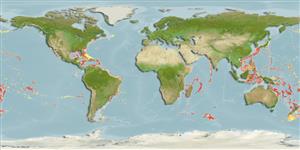Environment: milieu / climate zone / depth range / distribution range
Écologie
marin benthopélagique; profondeur 260 - 775 m (Ref. 57911). Deep-water
Widespread in tropical Atlantic and Indo-West Pacific Oceans.
Taille / Poids / Âge
Maturity: Lm ? range ? - ? cm
Max length : 37.1 cm TL mâle / non sexé; (Ref. 13608)
Description synthétique
Morphologie | Morphométrie
Vertèbres: 133 - 141. This species is distinguished by the following characters: with pectoral fin; dorsal-fin origin over tip of pectoral fin, predorsal length 14.0-17.1% TL; anus posterior, more than 1 head length behind pectoral fin, preanal length 26.8-28.8% TL; trunk long, trunk length 12.8-16.4% TL; intermaxillary teeth absent; vomer with 4 compound teeth; upper and lower jaws with multiple rows of teeth; head pores: IO 4, SO 3, M 6, POP 0, AD 1, ST 0, F 0; lateral-line pores absent; MVF 11-28-136, total vertebrae 133-141; colour of body light brownish dorsally, paler ventrally; dorsal and anal fins with white margin, posterior one third of anal-fin base and posterior one-seventh of anal fin black (Ref. 106136).
On the continental slope (Ref. 57911).
Life cycle and mating behavior
Maturité | Reproduction | Frai | Œufs | Fécondité | Larves
Uyeno, T., K. Matsuura and E. Fujii (eds.), 1983. Fishes trawled off Suriname and French Guiana. Japan Marine Fishery Resource Research Center, Tokyo, Japan. 519 p. (Ref. 13608)
Statut dans la liste rouge de l'IUCN (Ref. 130435)
Menace pour l'homme
Harmless
Utilisations par l'homme
Plus d'informations
Noms communsSynonymesMétabolismePrédateursÉcotoxicologieReproductionMaturitéFraiRassemblement de ponteFéconditéŒufsDéveloppement de l'œuf
Taille/ÂgeCroissanceLongueur-poidsLongueur-longueurFréquences de longueursMorphométrieMorphologieLarvesDynamique des populations larvairesRecrutementAbondanceBRUVS
RéférencesAquacultureProfil d'aquacultureSouchesGénétiqueElectrophoresesHéritabilitéPathologiesTraitementNutrientsMass conversion
CollaborateursImagesStamps, Coins Misc.SonsCiguateraVitesseType de nageSurface branchialeOtolithesCerveauxVision
Outils
Articles particuliers
Télécharger en XML
Sources Internet
Estimates based on models
Preferred temperature (Ref.
123201): 6.8 - 15.4, mean 10.1 °C (based on 336 cells).
Phylogenetic diversity index (Ref.
82804): PD
50 = 0.7500 [Uniqueness, from 0.5 = low to 2.0 = high].
Bayesian length-weight: a=0.00102 (0.00046 - 0.00225), b=3.06 (2.88 - 3.24), in cm total length, based on all LWR estimates for this body shape (Ref.
93245).
Niveau trophique (Ref.
69278): 3.8 ±0.3 se; based on size and trophs of closest relatives
Résilience (Ref.
120179): Faible, temps minimum de doublement de population : 4,5 à 14 années (Assuming tmax>10).
Fishing Vulnerability (Ref.
59153): Low to moderate vulnerability (27 of 100).
